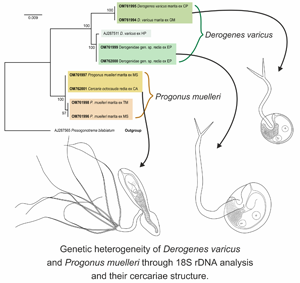Article contents
Species complexes and life cycles of digenetic trematodes from the family Derogenidae
Published online by Cambridge University Press: 15 August 2022
Abstract

The best way to study digenean diversity combines molecular genetic methods, life-cycle studies and elaborate morphological descriptions. This approach has been barely used for one of the most widespread digenean taxa parasitizing fish – the superfamily Hemiuroidea. Here, we applied the integrative approach to the hemiuroideans from the family Derogenidae parasitizing fish at the White and Barents Seas. Analysis of 28S, 18S, 5.8S rDNA, ITS2 and cox1 gene sequences from sexually adult worms (maritae) showed genetic heterogeneity for 2 derogenid species known from this area: Derogenes varicus and Progonus muelleri. Thus, 2 pairs of genetic lineages were found: DV1 and DV2, PM1 and PM2, respectively. Data from other regions indicate that 2 more lineages of D. varicus probably exist. Based on previous records from the White and Barents Seas, we hypothesized that the cercariae found in the moonsnails (family Naticidae) belong to the Derogenidae and may help to differentiate these lineages as species. According to our results, Cercaria appendiculata from Cryptonatica affinis matched DV1, similar nameless cercariae from Euspira pallida and Amauropsis islandica matched DV2, and Cercaria octocauda from C. affinis matched PM1. We provide new data on the structure of these cercariae and discuss the life-cycle pattern of the studied digeneans.
- Type
- Research Article
- Information
- Copyright
- Copyright © The Author(s), 2022. Published by Cambridge University Press
References
- 6
- Cited by



